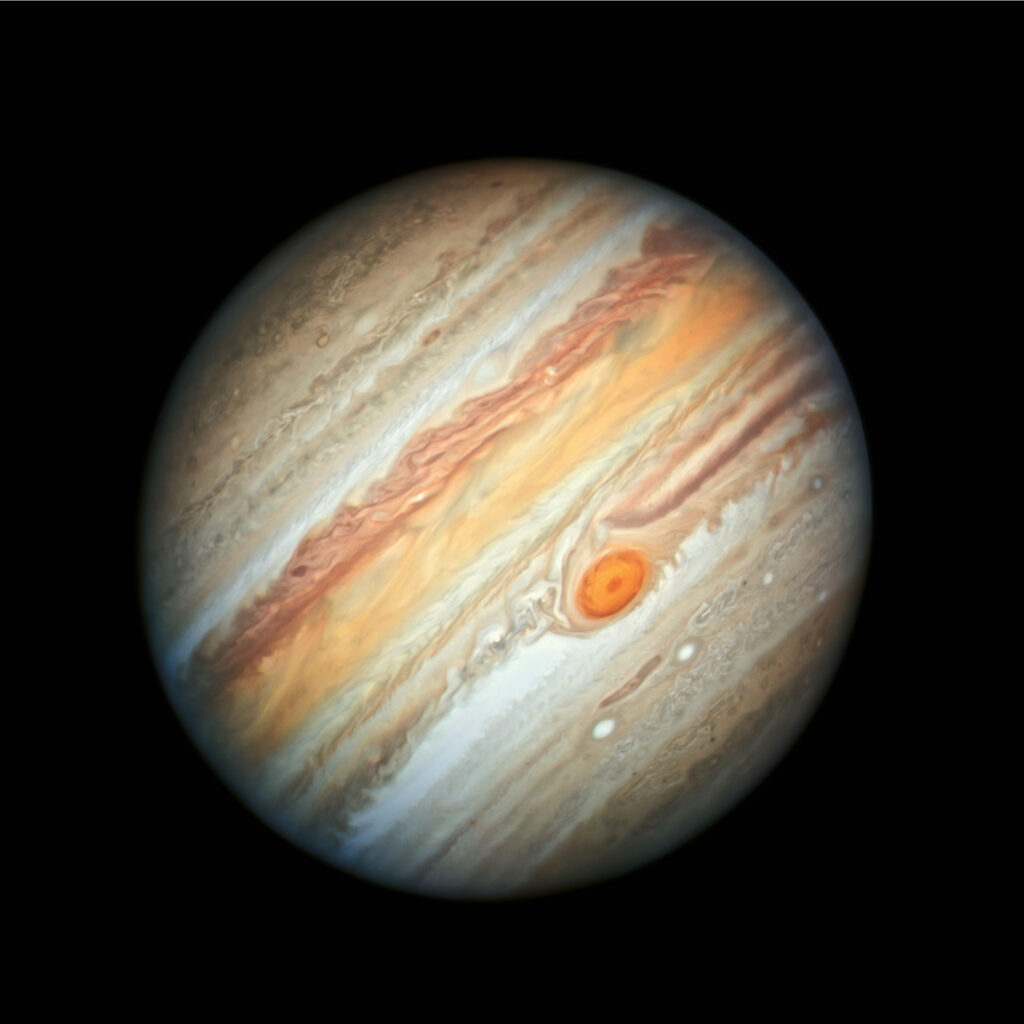Jupiter

Orbital semi-major axis is 5.20 A.U. or 778.4 million km.
Orbital eccentitricity is 0.048.
Perhilion 4.95 A.U. is 740.7 million km.
Aphelion is 5.46 A.U. or 816.1 million km.
Mean orbital speed is 13.1 km/s.
Sidereal orbital period is 11.86 tropical years.
Synodic orbital period is 398.88 solar days.
Orbital inclination to the ecliptic is 1.31*.
Greatest angular diameter, as seen from Earth is 50″.
Its mass is 1.901027 kg or 317.8 (Earth = 1), or twice the mass of all other planets in solar system combined.
Equatorial radius is 71,492 km or 11.21 (Earth = 1).
Mean density is 1330 kg/m3 or 0.241 (Earth = 1).
Surface gravity is 24.8 m/s2 or 2.53 (Earth = 1).
Escape speed is 59.5 km/s.
Sidereal rotation period is 0.41 solar days.
Axial tilt is 3.08*.
Surface magnetic field 12.89 (Earth = 1).
Magnetic axis tilt relative to rotation axis is 9.6*.
Surface temperature is around 124 k.
Central temperature may reach 40,000 k.
Number of moons is 16.
Equatorial bulge indicates a dense, probably rocky, core of around 10 to 20 times the mass of earth. This “terrestrial” planetary core is a vital stage in the evolution of a gas giant.
The two major features are the planets great red spot, which is a giant hurricane-like weather system that has been known to exist from earth-bound astronomers earliest observations of the planet, fading only at the poles. These bands are made up of bright zones of high pressure warm gas next to darker low pressure belts of cooler gas. Equatorial regions of the atmosphere are rotating faster then the planet, at a speed of some 85 m/s, or about 300 km/h, in the easterly direction. this is quite similar to Earths jet stream.
Voyager 1 flyby 1979.
Galileo atmosphere probe, December 1995 Probe survived for about an hour before being rushed by atmospheric pressure when it reached an altitude of 150km.Probe found atmosphere hotter, drier, and windier than expected.
The atmosphere is composed of 86.1 percent helium and small amounts of atmospheric methane, ammonia, and water vapor.
During the formation of the planet some of its gravitational energy was converted into heat in its interior. This excess heat continues to outpour today and is the source of the planets radiated heat, emitting about 4×10^17 watts energy beyond what it receives from the Sun.
The planet’s magnetosphere is over 30 million km across, approximately a million times greater than Earth’s. This is caused by the planets 40,000km thick inner layer of metallic hydrogen.
Of Jupiter’s 16 moons, perhaps the most notable is Io. Io is extremely volcanically active and has produced the first evidence of active extraterrestrial volcanic activity. Io’s atmosphere is primarily sulfur dioxide.
1979 Voyager missions discovered of a faint ring of matter encircling Jupiter in the plane of the planet’s equator around 50,000 km beyond the top cloud layer of the planet, yet before the orbit of the innermost moon.
Jupiter is the largest planet in the solar system.
Its mass is more than twice the mass of all the other planets combined, although it is still about 1/1000 the mass of the Sun.
It is composed primarily of hydrogen and helium. Jupiter rotates very rapidly, producing a pronounced equatorial flattening. The amount of flattening allows astronomers to infer the presence of a large rocky core in its interior.
Jupiter displays differential rotation-because the planet has no solid surface, the rotation rate varies from place to place in the atmosphere. Measurements of radio emission from Jupiter’s magnetosphere provide a measure of the planet’s interior rotation rate.
Jupiter’s atmosphere consists of three main cloud layers. The colors we see are the result of chemical reactions, fueled by the planet’s interior heat, solar ultraviolet radiation, auroral phenomena, and lightning, at varying depths below the cloud tops, seen through “holes” in the overlying clouds. The cloud layers on Jupiter, as on all the jovian worlds, are arranged into bands of bright zones and darker belts crossing the planets parallel to the equator. The bands are the result of convection in the planet’s interior and the planet’s rapid rotation. The lighter zones are the tops of upwelling, warm currents, and the darker bands are cooler regions where gas is sinking. Underlying them is a stable pattern of eastward or westward wind flow called the zonal flow. The wind direction alternates as we move north or south away from the equator.
The main weather pattern on Jupiter is the Great Red Spot, an Earth-sized hurricane that has been raging for at least three centuries. Other, smaller, weather systems-the white and brown ovals-are also observed. They can persist for decades.
Jupiter’s atmosphere becomes hotter and denser with depth, eventually becoming liquid. Interior pressures are so high that the hydrogen is “metallic” in nature near the center. The planet has a large “terrestrial” core 10-20 times the mass of Earth.
Jupiter radiates about twice as much energy into space as it receives from the Sun. The source of this energy is most likely heat left over from the planet’s formation 4.6 billion years ago.
The magnetosphere of Jupiter is about a million times more voluminous than Earth’s magnetosphere, and the planet has a long magnetic “tail” extending away from the Sun to at least the distance of Saturn’s orbit. Energetic particles spiral around magnetic field lines, accelerated by Jupiter’s rotating magnetic field, producing intense radio radiation.